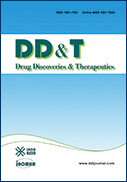Volume 13, Issue 6
Displaying 1-10 of 10 articles from this issue
- |<
- <
- 1
- >
- >|
Original Articles
-
Article type: research-article
2019Volume 13Issue 6 Pages 299-305
Published: December 31, 2019
Released on J-STAGE: January 20, 2020
Download PDF (877K) -
Article type: research-article
2019Volume 13Issue 6 Pages 306-313
Published: December 31, 2019
Released on J-STAGE: January 20, 2020
Download PDF (2808K) -
Article type: research-article
2019Volume 13Issue 6 Pages 314-321
Published: December 31, 2019
Released on J-STAGE: January 20, 2020
Download PDF (2648K) -
Article type: research-article
2019Volume 13Issue 6 Pages 322-327
Published: December 31, 2019
Released on J-STAGE: January 20, 2020
Download PDF (365K) -
Article type: research-article
2019Volume 13Issue 6 Pages 328-334
Published: December 31, 2019
Released on J-STAGE: January 20, 2020
Download PDF (1015K) -
Article type: research-article
2019Volume 13Issue 6 Pages 335-342
Published: December 31, 2019
Released on J-STAGE: January 20, 2020
Download PDF (780K) -
Article type: research-article
2019Volume 13Issue 6 Pages 343-353
Published: December 31, 2019
Released on J-STAGE: January 20, 2020
Download PDF (1761K)
Brief Reports
-
Article type: research-article
2019Volume 13Issue 6 Pages 354-359
Published: December 31, 2019
Released on J-STAGE: January 20, 2020
Download PDF (467K) -
Article type: research-article
2019Volume 13Issue 6 Pages 360-364
Published: December 31, 2019
Released on J-STAGE: January 20, 2020
Download PDF (500K)
Communication
-
2019Volume 13Issue 6 Pages 365-369
Published: December 31, 2019
Released on J-STAGE: January 20, 2020
Download PDF (438K)
- |<
- <
- 1
- >
- >|
